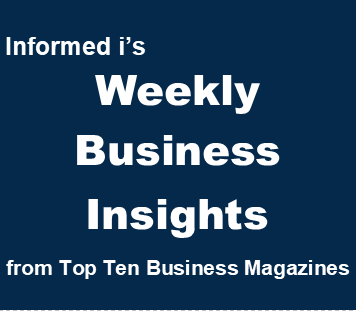
Informed i’s Weekly Business Insights
Extractive summaries and key takeaways from the articles carefully curated from TOP TEN BUSINESS MAGAZINES to promote informed business decision-making | Since 2017 | Week 387 | February 7-13, 2025 | Archive

The CEO as elite athlete: What business leaders can learn from modern sports
By Bob Sternfels and Daniel Pacthod | McKinsey & Company | January 30, 2025
Extractive Summary of the Article | Listen
3 key takeaways from the article
- Today’s athletes are unquestionably better than those from even 25 years ago. For today’s chief executive officers, there’s a lot to learn from that remarkable progress. And the need is urgent, primarily because the playing field has become radically more difficult.
- In 2024, based on research, the authors identified a number of traits required for 21st-century leaders: positive energy; selflessness and a sense of service; a belief in continuous learning; grit and resilience; levity; and an acceptance of stewardship.
- How to get past the challenges of “living into” these attributes. We learned that the best leaders today have made a generational change in their thinking, one that closely parallels how elite athletes prepare, train, and compete. In several ways, the two jobs—CEO and athlete—are highly correlated. Here are five leadership practices of great athletes that business leaders can adapt to their own work. They use their time purposefully. They perfect the art of recovery. They are always learning. They embrace data and analytics. They are adaptable and resilient.
(Copyright lies with the publisher)
Topics: Leadership, Transformation, Continuous Learning, Adaptability, Resilience, Purpose
Click for the extractive summary of the articleSports fans love to compare today’s athletes to the legends of the past and speculate about who’s the best. While many of us cherish our childhood memories, it’s a cold, hard fact that, in almost every case, today’s athletes would handily defeat their predecessors. As a flamethrowing relief pitcher said in 2018, if Babe Ruth, arguably one of the greatest players in major league history, were playing today, “I would strike him out every time.”
Exaggeration? Maybe a little. But it’s undeniable that today’s athletes in every sport are bigger, stronger, faster, better coached, better rested, better fed, better equipped, and more prepared. The development of sports technology and sports science—new ideas in nutrition, recovery, in-game strategy, coaching, athletic techniques, you name it—means that today’s athletes are unquestionably better than those from even 25 years ago.
For today’s chief executive officers, there’s a lot to learn from that remarkable progress. And the need is urgent, primarily because the playing field has become radically more difficult. CEOs are on the job 24/7, responsible for addressing an ever-shifting array of problems and threats, even when there is incomplete information (usually) and when every move is under scrutiny (constantly). Not only do CEOs have to deal with a wide range of stakeholders, all of them with their own priorities, but employees are increasingly demanding—as they should be. Plus, technology is changing at warp speed, and the geopolitical environment is unsettled. When companies slip up, they are judged harshly, not least through social media.
The 2024 based on research, the authors identified a number of traits required for 21st-century leaders: positive energy; selflessness and a sense of service; a belief in continuous learning; grit and resilience; levity; and an acceptance of stewardship. Since that time, they have been in dialogue with CEOs about how to get past the challenges of “living into” these attributes. We learned that the best leaders today have made a generational change in their thinking, one that closely parallels how elite athletes prepare, train, and compete. In several ways, the two jobs—CEO and athlete—are highly correlated. Here are five leadership practices of great athletes that business leaders can adapt to their own work. They use their time purposefully. They perfect the art of recovery. They are always learning. They embrace data and analytics. They are adaptable and resilient.
show less